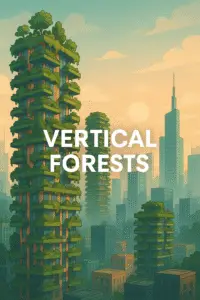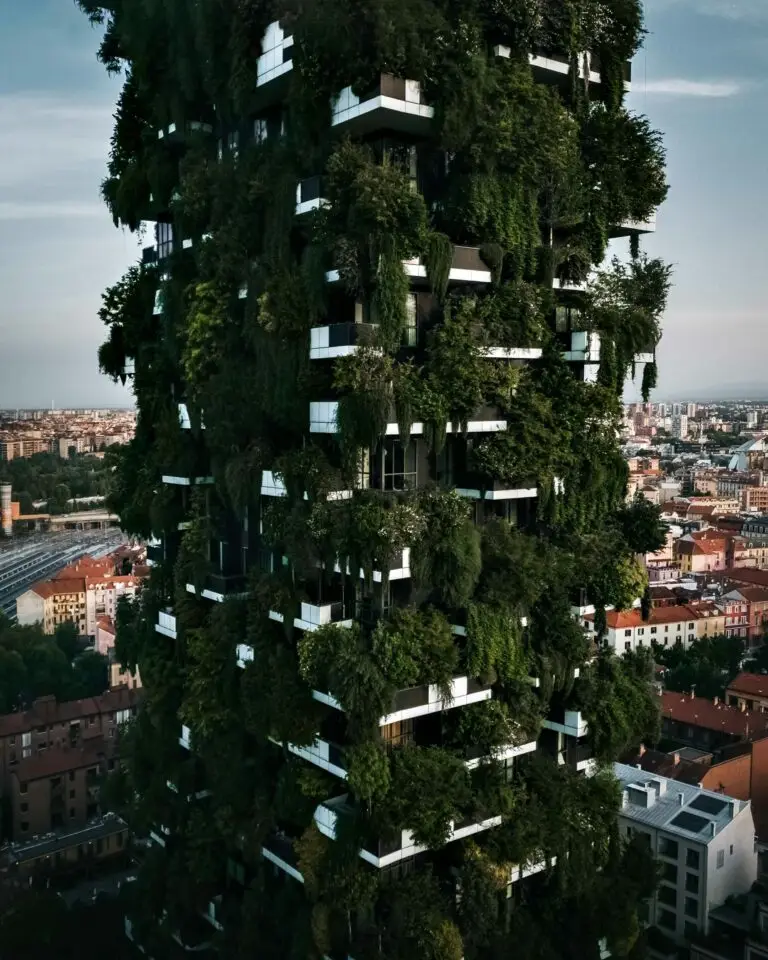Table of Contents
ToggleWhat Is a Vertical Forest and Why Is It Needed in Cities?

In the era of rapid urbanisation space is low and human beings are more. People are not getting enough space for living in urban areas. Here comes a major problem: there is no space left for humans, so how can we plant trees and greenery? The traditional architectures faced challenges. They had to improve the air quality and surroundings as well.
The concept of vertical forests was first introduced by an Italian architect. Vertical forest high-rise buildings which incorporate small plants, shrubs, herbs, and grasses. In this blog, we will discuss this topic very deeply and cover all the aspects, like hidden vertical forest benefits , vertical forest design, and living wall architecture, which are either not covered or not available in depth.
What Are the UnKnown Benefits of Vertical Forests?
There are a lot of green wall benefits. In this section, we are covering those vertical forest benefits that are rarely covered.They didn’t get priority but they are bringing major changes in the environment here are some :-
1. Urban Breeze cycle enhancement : urban bleach cycle is a natural phenomenon in which air flows toward the centre of the city at lower altitude and goes away from the city at higher altitude. This phenomenon occurs due to the variation in the temperature between urban areas and rural areas.
Vertical forest helps in guiding and modifying the natural wind patterns. It brings natural winds to the high-density urban zones. In Sacramento, expanding tree canopy led to a 7% reduction in peak ozone levels and a 50% drop in smog events, according to the US Forest Service. It also helps in air quality improvement.
2. Greywater Bio-filtration in facade plant : currently, vertical forests are designed in a way that they can filter grey water through the facade-integrated vegetation. It helps in the reduction of stormwater runoff. The grey water bio-filtration also helps introduce load on the sewage system . The water is reused by the plants. The University College London (UCL) “Total Value Wall” study reported a 90% reduction in Total Suspended Solids (TSS) and 82% drop in Chemical Oxygen Demand (COD) using green walls.
3. VR mimic stress buffering – Biophilic illusion: biophilic illusion is the design philosophy which says that we humans like either nature visuals and sensory or real connection with it, for well-being and mental health. Virtual reality mimic means if real plants are not available but greenery is present on the walls of a building, either digitally or any fake illusion, our brain gives a natural response.
Studies have proven that whenever a person sees green vertical walls, their cortisol level ( stress hormone) gets reduced. A 2023 randomized trial in Philadelphia showed that vacant-lot greening led to a 41–68% decrease in depression symptoms.
4. Boosting social cohesion(connection) and education: many local communities are appointed for the maintenance of the vertical forest, especially in low-income housing or urban community blocks. The community takes a collective responsibility for the maintenance. They performed watering, pruning and cleaning of the structure
Studies show that visible greenery in residential areas increases neighborhood social cohesion and interaction. It also helps in the reduction of crime and isolation in this region. When the vertical forest is made outside the school or the classroom, children interact with the vertical forest, and the Teachers give them knowledge about it, like living wall architecture, vertical forest benefits.
5. Urban densification issue : vertical forest offers a solution for cities that lack space due to overpopulation. The main aim was to create building without harming greenery. When more people come to the cities, they require space for living and hence it leads to vertical expansion. The main idea was to cover building walls with greenery if the ground spaces are not left for them.
Key benefits :- No extra land use , greenery is created on the existing buildings , it controls urban sprawl, and also maintains ecological balance.
6. Localise ozone reduction effect : when vehicle emissions and industrial pollutants come into contact with the sunlight, they create ground-level ozone, which is also called bad ozone, which causes asthma, lung inflammation, and problems in breathing. Bad ozone exists at the building’s height (10m – 30m).
The plants and the greenery present on the wall absorb ozone molecules , filter and neutralize them. This specifically works well on mid to high-level buildings. And it is more useful near hospital buildings and schools. The Sacramento urban tree study found up to 34% reduction in population-weighted ozone exposure in targeted zones.

How Does Vertical Forest Design Work in Modern Architecture?
Vertical garden design is complex but not hard. Green wall architecture requires a certain level of patience to let plants grow properly. We will now understand the vertical garden irrigation system also.
1. Biological architecture : traditional buildings use dead materials like glass, Steel, concrete, and iron, but vertical forest involves live organisms like plants, bees, and other insects. Their design involves multiple layers
Primary layer includes structural steel and concrete core, secondary layer involves planter boxes with artificially made water drainage system, tertiary layer which includes route and code system to support full growth, not only shrubs or climbers. And that’s what we call ecological engineering.
2. Wind resistance and root box engineering : You might be thinking that a green roof is a little bit similar to vertical forest, but unlike a green roof, vertical forest supports deep-rooted and medium-sized plants. Design must withstand wind shear , weight shift, and seasonal leaf density variations hence specially designed Steel reinforced root boxes are embedded with load handling plates and aerodynamic logical placements. To know more about green roofs visit our page
3. Intelligent irrigation and greywater : these buildings do not perform manual watering; instead, they use an AI-powered irrigation system, a humidity sensor, and an automatic greywater bio-filtration cycle. These buildings use rainwater harvesting layers in facades. All these things make the building a closed-loop living ecosystem.
4. Perfect positioning : vertical forest plants are not just randomly placed, they are perfectly placed for effective photosynthesis. A vertical forest can be divided into three layers for perfect positioning. At the bottom level air purifying and noise reducing species are planted like bamboo and ficus. The mid layer favours pollinator-friendly plants that attract birds and insects, helping urban biodiversity. At the top layer house drought drought-tolerant plants are placed which can resist wind and they have shallow root system
5. Maintenance optimised green building: unlike rooftop gardens, vertical forest recovers aerial accessibility. Every planting module is designed for detachment so that the plant can be replaced without using scaffolding. Maintenance of vertical forest manually is very risky hence nowadays drones and robot arms are deployed for the maintenance. Plants are attached with a QR code for automated watering schedules care logs and species information .
Which Real-Life Vertical Forests Show Living Wall Architecture in Action?
1. Indian example Forest office, Pune, Maharashtra. Architect : studio VDGA , completed in 2019 , located in Pune, Maharashtra, INDIA. This office is a rare example of the corporate vertical forest concept in India. It has dense plantation in facade including plants such as bamboo, shrubs vertical creepers. They regulate temperature naturally. It has grey water and rainwater harvesting system. It also helps in energy reduction by around 35-40%. It is a commercial building in which this greenery is not only used for aesthetic look but also used for thermal insulation, acoustic dampening, and psychological comfort.
2. Bosco vertical, Milan, Italy. Architect: Stefano Boeri Architetti, completed in 2014 , located in Milan, Italy. This vertical forest is the world’s 1st full-fledged vertical forest with up to 800 trees and 5000 shrubs on balconies. It reduces urban heat by 2°C in the surroundings. It generates 60 kg of oxygen per resident every year. This biodiversity includes birds, bees, and butterflies. One unique point is that Posco Vertical Milan is not just a design architecture, but it also redefines urban ecology. It’s a living example of architecture meeting forest climate.

What Are the Future Prospects, Challenges, and Disadvantages of Vertical Forests?
1. Upcoming future
We know that AI is evolving, the upcoming vertical forest could be AI-operated. In the future, these buildings will use AI-powered sensors to auto-monitor soil moisture level, air pollution absorption capability, and plant health. Different and new types of plants will also be included, like before, only ornamental plants were added, but now, pollinator-friendly plants , micro wetland modules, and even genetically modified plants are being added to these buildings. Nesting boxes are also placed for the birds.
Currently, it was only for expensive cities, and it was not affordable for low-income housing, but in the future, it will be affordable because many developing countries, like India, Brazil, and the Philippines, are building modular vertical gardens. Fresh air and thermal comfort could reach to urban poor areas

2. Management (A lot of systems are used but only uncovered topics are mentioned below)
Management of vertical forest is not only handled by gardeners, but it needs a multi-disciplinary maintenance team. These are the staff members, experts in their field – arborists (tree health experts), horticulturists( plant selection and nutrition), facade climbers, irrigation technicians, and AI system engineers. BOSCO VERTICAL FOREST has dedicated tree climbers who rappel down skyscrapers for pruning.
Smart irrigation and moisture monitoring systems for regular water supply and plant health. Ecological load monitoring system for ensuring root expansion, rainwater retention, and structural integrity. This system uses dynamic structural sensor
3. Disadvantages
Urban wildlife conflict, bird nesting near the balcony window makes too noise and is unhygienic. Bees are insects that form colonies near the balconies, which makes it inhabitable and risky, if bees colony attack certain residents.
Vertical forest buildings are required continuously in water-scarce countries, which creates pressure on the local government, such as municipalities. Poorly treated greywater can lead to pathogen spawning.
In affordable housing, a lack of funding is common, and ultimately due to improper maintenance, plants and shrubs get dry and create a poor look, which decreases building value.
Ending up :- Re thinking the concrete jungle.
These vertical forest buildings are more than just green facades, they are living , breathing structures which is completely different from our traditional buildings. From battling pollution to boosting biodiversity, vertical forest benefits are amazing. The management requires planning precision and a team. Vertical forest also has some disadvantages, but only when the monitoring/management team is not working effectively. If Something has pros, then there are cons also.
